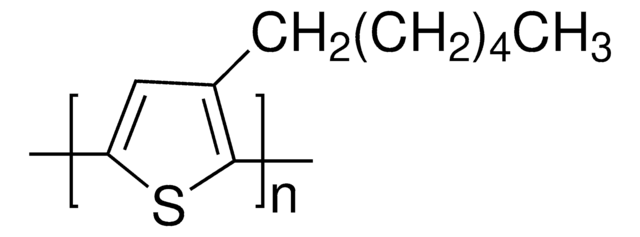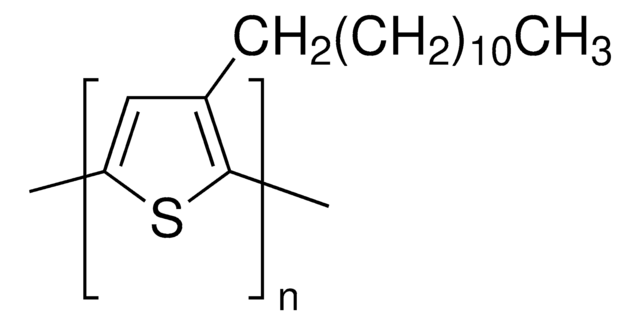推荐产品
物料
black
等级
electronic grade
描述
Band gap: 1.7 eV
方案
99.995% trace metals basis
表单
solid
分子量
average Mn ~25,000
mp
198-211 °C
轨道能量
HOMO -5.25 eV
LUMO -3.55 eV
OPV设备性能
ITO/PEDOT:PSS/P3OT:PC61BM (1:2)/LiF/Al
- Short-circuit current density (Jsc): 5.55 mA/cm2
- Open-circuit voltage (Voc): 0.5 V
- Fill Factor (FF): 0.33
- Power Conversion Efficiency (PCE): 0.91 %
半导体性质
P-type (mobility=10−4 - 10−1 cm2/V·s)
SMILES字符串
[s]1cc(cc1)CCCCCCCC
InChI
1S/C12H20S/c1-2-3-4-5-6-7-8-12-9-10-13-11-12/h9-11H,2-8H2,1H3
InChI key
WQYWXQCOYRZFAV-UHFFFAOYSA-N
一般描述
应用
Rechargeable battery electrodes, electrochromic devices, chemical and optical sensors, light-emitting diodes, microelectrical amplifiers, field-effect transistors and non-linear optical materials.
Used in organic field-effect transistors and in polymer-based solar cells.
特点和优势
储存分类代码
11 - Combustible Solids
WGK
WGK 3
闪点(°F)
Not applicable
闪点(°C)
Not applicable
个人防护装备
Eyeshields, Gloves, type N95 (US)
其他客户在看
商品
The application of conducting polymers at the interface with biology is an exciting new trend in organic electronics research.
Organic materials in optoelectronic devices like LEDs and solar cells are of significant academic and commercial interest.
Intrinsically stretchable active layers for organic field-effect transistors (OFET) are discussed. Polymer structural modification & post-polymerization modifications are 2 methods to achieve this.
Novel Graphene‑Based Nanostructures Production, Functionalization, and Engineering
相关内容
Optoelectronic devices such as light-emitting diodes (LEDs), solar cells, and light-emitting field effect transistors (FETs) that utilize organic materials as their light harvesting and/or charge transporting component have been the subject of much academic and commercial attention.
Active Filters
我们的科学家团队拥有各种研究领域经验,包括生命科学、材料科学、化学合成、色谱、分析及许多其他领域.
联系客户支持

![聚[双(4-苯基)(2,4,6-三甲基苯基)胺] a poly(triaryl amine) semiconductor](/deepweb/assets/sigmaaldrich/product/structures/122/933/c34a34ab-284f-4890-adb8-126247a91d9b/640/c34a34ab-284f-4890-adb8-126247a91d9b.png)





